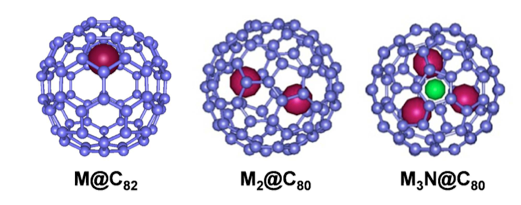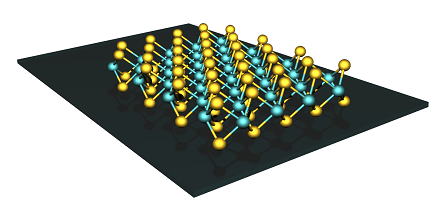Research Areas
(1) Synthesis, Functionalization and Properties of Metallofullerenes
Fullerenes are molecular carbon allotropes with closed cage-like structures. The internal hollow space of fullerenes can adopt atoms, ions, clusters or molecules to form the so-called endohedral fullerenes. When metal atoms or metallic clusters are entrapped inside fullerenes, electron transfer occurs from the metal atoms or metallic clusters to the fullerene cages. As a consequence, the metallofullerenes usually exhibit different chemical and physical properties from the parent empty fullerenes. Metallofullerenes have potential applications in fields of biomedicine, organic photovoltaics and quantum information processing. Our research focuses on the synthesis and functionalization of metallofullerenes with novel structures and properties.

Molecular Structures of Metallofullerenes
(2) Quantum-Chemical Studies of Metallofullerenes
Theoretical studies on endohedral metallofullerenes are of great significance for understanding their structures and properties. Many useful information can be obtained from theoretical studies, such as the stability, electronic structure and chemical reactivity of metallofullerenes. Quantum-chemical calculations has been proved to be successful in predicting the stable structures of metallofullerene isomers. We are interested in molecular design and analysis of metallofullerenes and other molecules by using the theoretical methods.
(3) Synthesis, Properties and Applications of Two-Dimensional Nanomaterials
Novel properties may arise when the size of a material is decreased to the nanoscale and the dimension is lowered due to quantum confinement effects and edge effects. Two-dimensional nanomaterials have been the focus of substaintial research because of their extraordinary physical properties. We are interested in developing new synthetic methods for high quanlity two-dimensional nanomaterials including graphene, layered transition-metal compounds, etc. We also aim at exploring the properties and applications of two-dimensional materials in electrochemical energy storage and conversion.

A Structure Model of Transition-Metal Sulfide
copyright (c) Zhiyong Wang Group 2017-2024 京公网安备110402430004号 | 京ICP备05066828号-1